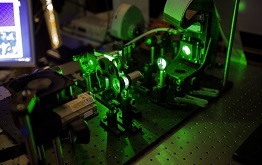23/11/15
The LightOn project was developed by six inventors, including two professors from UPMC, in the Kastler-Brossel Laboratory (UPMC/CNRS/ENS/Collège de France) and the Statistical Physics Laboratory (ENS/CNRS/UPMC), as well as a professor from University Paris-Diderot, member of the Langevin Institute (ESPCI/U. Paris-Diderot/UPMC/CNRS/INSERM). The project is the result of a longstanding and interdisciplinary collaboration between the inventors on optical information processing.
The startup LIGHTON, which will be incubated by Agoranov and may benefit from PSL maturation programs, proposes an alternative to generic processors (CPU)1 and graphics processors (GPU)2, usually used in the analysis of Big Data. Its patented technology3 relies on a device based on optical processing of information, and may be used as an ultrafast and low-energy co-processor for big data analysis.
The solution proposed by LightOn will use a new class of algorithms that have been developed over the last few years, based on random data projections. “Mixing” data in a controlled and reproducible manner enables the extraction of meaningful information, i.e. to maintain the structure of the data, without being troubled by their variability. For instance, one can use the result of these random projections for classification tasks. The limiting factor for the wide adoption of such algorithms is the computation of these random projections: the solution brought by LightOn performs this operation optically, without the need for numerical computation, with marginal energy consumption and at the speed of light. This technology can be applied to data sizes that are too large for even with the best conventional graphic processors (GPU) to address.
LightOn’s technology therefore offers a potential alternative to conventional processing or co-processing units (CPUs and GPUs) to cope with the exponential growth of the amount of data. Thanks to its low electric consumption compared to CPU/GPU solutions, (few Watts versus several tens or hundreds of Watts), this technology could be used to apply machine learning to large data sets (for instance in genomics or the Internet of Things), without increasing energy consumption. Finally, LightOn’s technology could provide a solution to the problem of security and anonymity of our online data.
LightOn is the result of a longstanding and interdisciplinary collaboration between the inventors on optical information processing:
Sylvain Gigan professor at UPMC in Kastler-Brossel Laboratory (UPMC/CNRS/ENS/Collège de France) is specialist of optics in complex media; Laurent Daudet, professor at university Paris Diderot and the Langevin Institute (ESPCI ParisTech/Paris Diderot/UPMC/CNRS/INSERM) is specialist of signal processing; Florent Krzakala, professor at UPMC in the statistical Physics Laboratory (ENS/CNRS/UPMC) is specialist of statistical physics applied to algorithms; and Igor Carron, independent researcher and consultant, is specialist in Machine Learning.
Together, and with the help of Alaa Saade, PhD student at ENS, and Angélique Drémeau, postdoctoral researcher at CNRS, they have explored how optics in complex media could benefit from signal processing and algorithmic tools. They have shown that their optic solution can offer a more straight-forward method for performing calculations for random projections in machine learning that are particularly laborious when performed on a chip. This is the idea at the heart of the LightOn start-up project.
1Generic processors (CPU) designate the processing unit or main microprocessor of a computer.
2 A GPU co-processor is an integrated circuit of a graphics card that provides display functions particularly on computers.
3Patent number EP 15305165, Digital-data-mixing apparatus and digital data processing system, filed February 4, 2015 in the names of the Paris Sciences et Lettres Foundation, ESPCI INNOV, Paris Diderot University - Paris 7, CNRS and Mr. Igor Carron.
http://www.upmc.fr/en/press_office/the_lighton_project_goes_into_incubation.html













